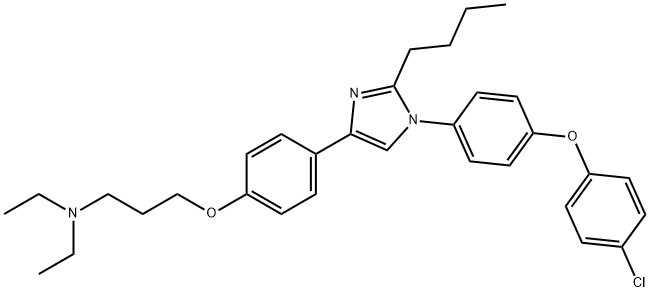- Azeliragon
-

- $33.00 / 2mg
-
2025-11-09
- CAS:603148-36-3
- Min. Order:
- Purity: 98.33%
- Supply Ability: 10g
- Azeliragon
-

- $1.00 / 1KG
-
2019-09-06
- CAS:603148-36-3
- Min. Order: 1KG
- Purity: 95%~99%
- Supply Ability: per week 100kg
|
| | Azeliragon Basic information |
| Product Name: | Azeliragon | | Synonyms: | 1-PropanaMine, 3-[4-[2-butyl-1-[4-(4-chlorophenoxy)phenyl]-1H-iMidazol-4-yl]phenoxy]-N,N-diethyl-;CRL 40G;3-(4-(2-butyl-1-(4-(4-chlorophenoxy)phenyl)-1H-imidazol-4-yl)phenoxy)-N,N-diethylpropan-1-amine;AZELIRAGON;3--4--2-Butyl-1--4--4-chlorphenoxy-phenyl--1H-imidazol-4-yl-phenoxy--N-N-diethylpropan-1-amin;N-[3-[4-[2-Butyl-1-[4-(4-chlorophenoxy)phenyl]-1H-imidazol-4-yl]phenoxy]propyl]-N,N-diethylamine;Azeliragon (TTP488);Azeliragon(PF-04494700,TTP488) | | CAS: | 603148-36-3 | | MF: | C32H38ClN3O2 | | MW: | 532.12 | | EINECS: | 814-441-9 | | Product Categories: | Inhibitors | | Mol File: | 603148-36-3.mol |  |
| | Azeliragon Chemical Properties |
| Boiling point | 667.7±65.0 °C(Predicted) | | density | 1.11±0.1 g/cm3(Predicted) | | storage temp. | Store at -20°C | | solubility | DMSO:50.33(Max Conc. mg/mL);94.58(Max Conc. mM)
DMF:5.0(Max Conc. mg/mL);9.4(Max Conc. mM)
DMF:PBS (pH 7.2) (1:2):0.33(Max Conc. mg/mL);0.62(Max Conc. mM)
Ethanol:50.5(Max Conc. mg/mL);94.9(Max Conc. mM) | | form | A crystalline solid | | pka | 10.16±0.25(Predicted) | | color | White to light yellow | | InChIKey | KJNNWYBAOPXVJY-UHFFFAOYSA-N | | SMILES | C(N(CC)CC)CCOC1=CC=C(C2=CN(C3=CC=C(OC4=CC=C(Cl)C=C4)C=C3)C(CCCC)=N2)C=C1 |
| | Azeliragon Usage And Synthesis |
| Uses | Azeliragon (TTP488) is an orally bioavailable inhibitor of the receptor for advanced glycation end products (RAGE) in development as a potential treatment to slow disease progression in patients with mild Alzheimer’s disease (AD)[1]. Azeliragon also can cross the blood-brain barrier (BBB)[2]. | | Biological Activity | Azeliragon (TTP488, PF-04494700) is an orally bioavailable small molecule inhibitor that inhibits the receptor for advanced glycation end products (RAGE). RAGE is an immunoglobulin-like cell surface receptor that is overexpressed in the brains of Alzheimer's patients. | | in vivo | Azeliragon (100 mcg/d; intraperitoneal injection; every day) treatment reduces syngeneic islet graft and islet allograft in NOD and B6 mice (Islets were isolated from young prediabetic NOD/LtJ mice and transplanted into NOD mice with spontaneous diabetes; islets were isolated from WT BALB/c mice and transplanted into B6 mice with diabetes)[3]. | Animal Model: | Prediabetic NOD/LtJ (6-7 week old) mice, NOD mice with spontaneous diabetes, WT BALB/c mice (8-10 week old) and B6 mice with diabetes [3]. | | Dosage: | 100 mcg/d | | Administration: |
Intraperitoneal injection; every day | | Result: | Prolonged islet auto and allograft survival.
|
| | target | | Target | Value | RAGE
() | | References | [1] Burstein AH, et al. Assessment of Azeliragon QTc Liability Through Integrated, Model-Based Concentration QTc Analysis. Clin Pharmacol Drug Dev. 2019 May;8(4):426-435. DOI:10.1002/cpdd.689
[2] Bongarzone S, et al. Targeting the Receptor for Advanced Glycation Endproducts (RAGE): A Medicinal Chemistry Perspective. J Med Chem. 2017 Sep 14;60(17):7213-7232. DOI:10.1021/acs.jmedchem.7b00058
[3] Chen Y, et al. RAGE ligation affects T cell activation and controls T cell differentiation. J Immunol. 2008 Sep 15;181(6):4272-8. DOI:10.4049/jimmunol.181.6.4272 |
| | Azeliragon Preparation Products And Raw materials |
|
|
Tag:Azeliragon(603148-36-3)
Related Product Information
|
|
|
According to the laws, regulations and policies related to "patent products", the sale of this product is prohibited!
ChemicalBook prompt
The patent owner or licensee of the product has not released any relevant information for the time being.
|